人教版(2019)选择性必修第三册 Unit 1 Art Reading and Thinking 课件 (16张PPT)
文档属性
| 名称 | 人教版(2019)选择性必修第三册 Unit 1 Art Reading and Thinking 课件 (16张PPT) | 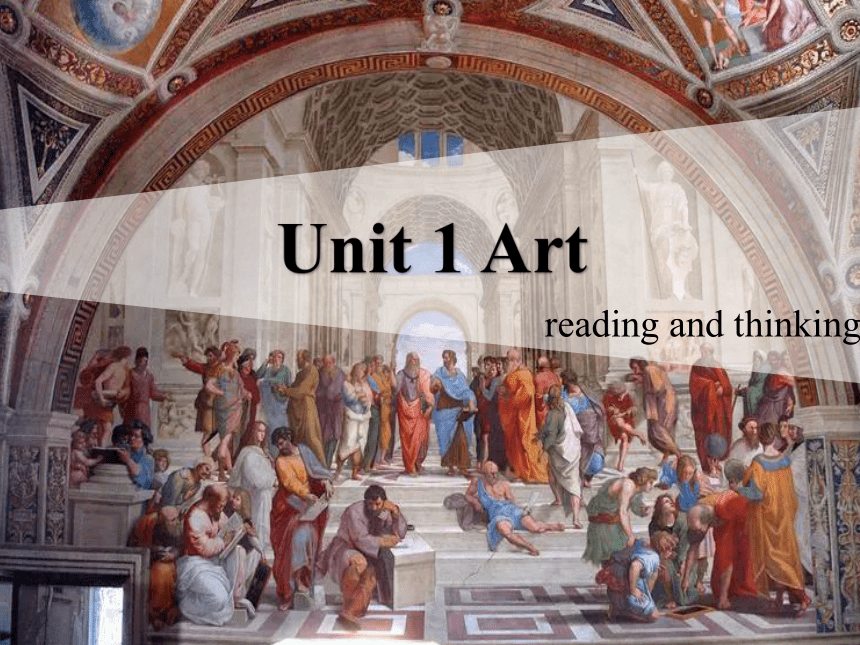 | |
| 格式 | pptx | ||
| 文件大小 | 8.5MB | ||
| 资源类型 | 教案 | ||
| 版本资源 | 人教版(2019) | ||
| 科目 | 英语 | ||
| 更新时间 | 2024-02-26 12:28:13 | ||
图片预览

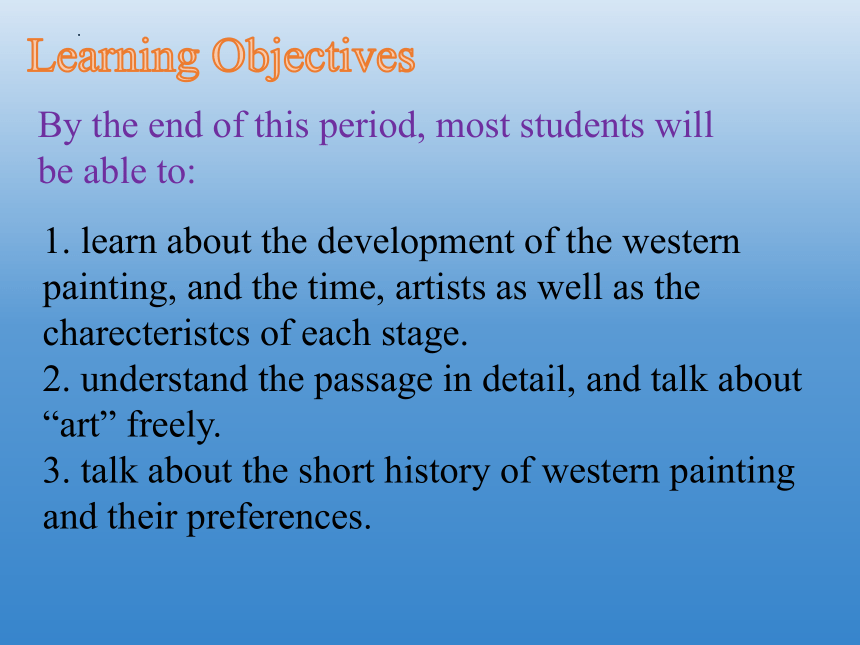

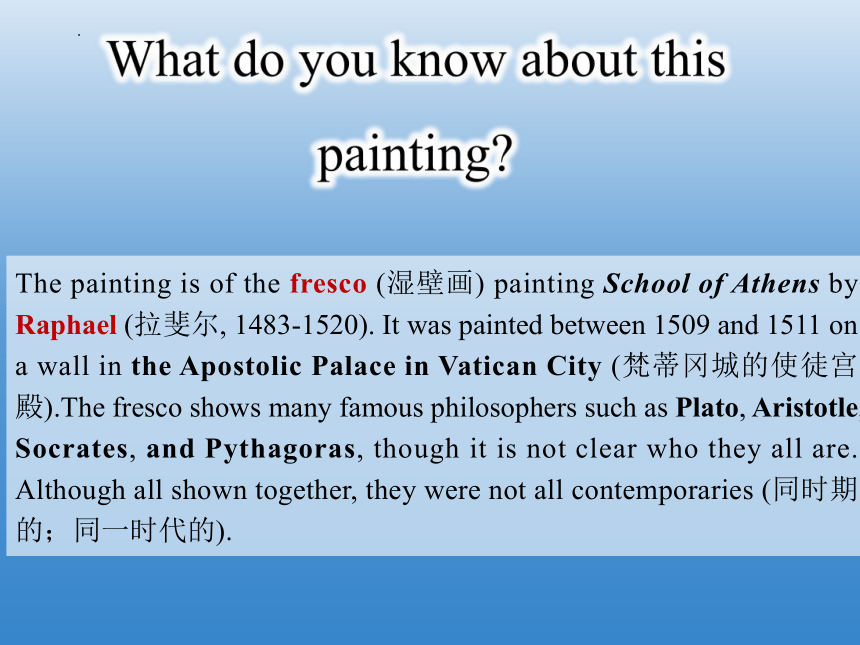
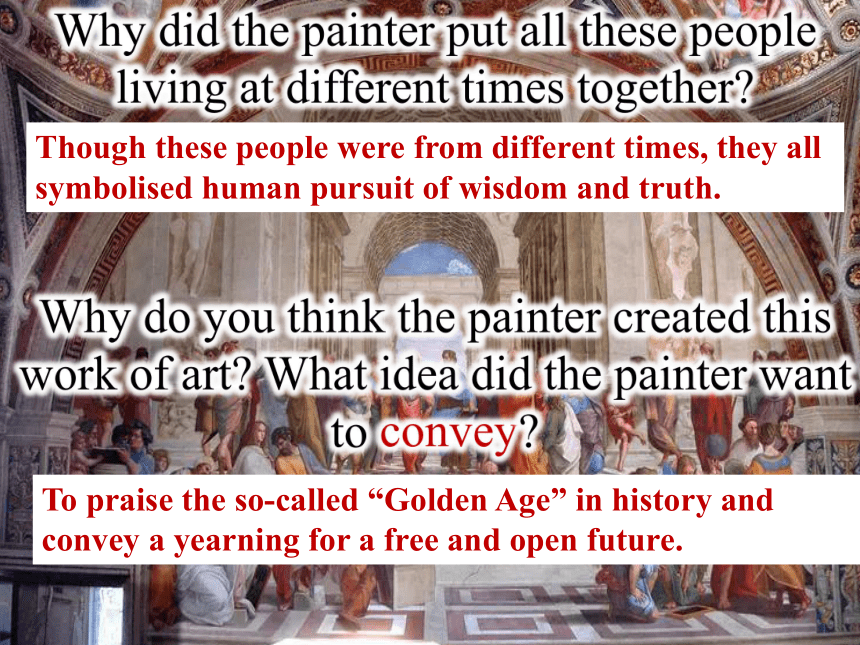
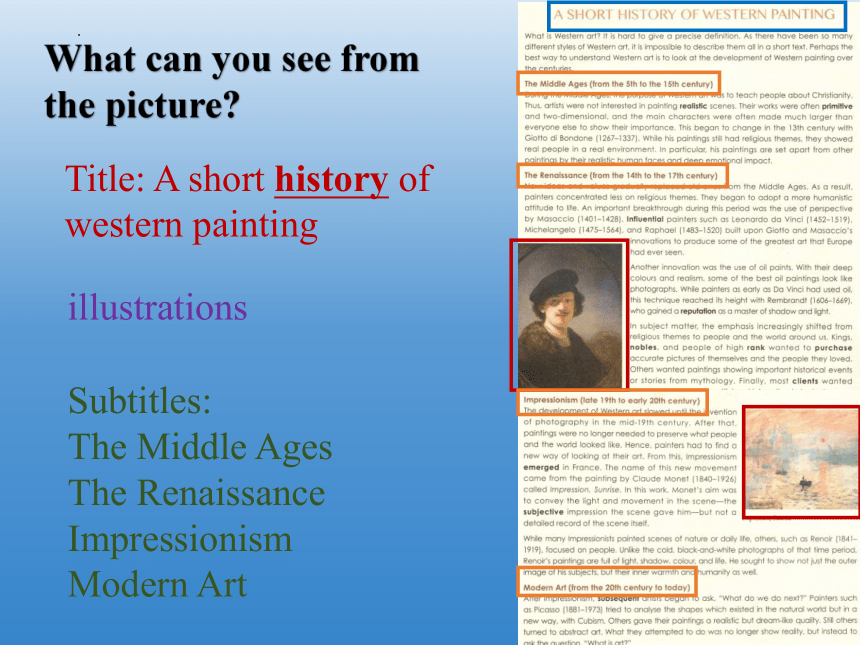
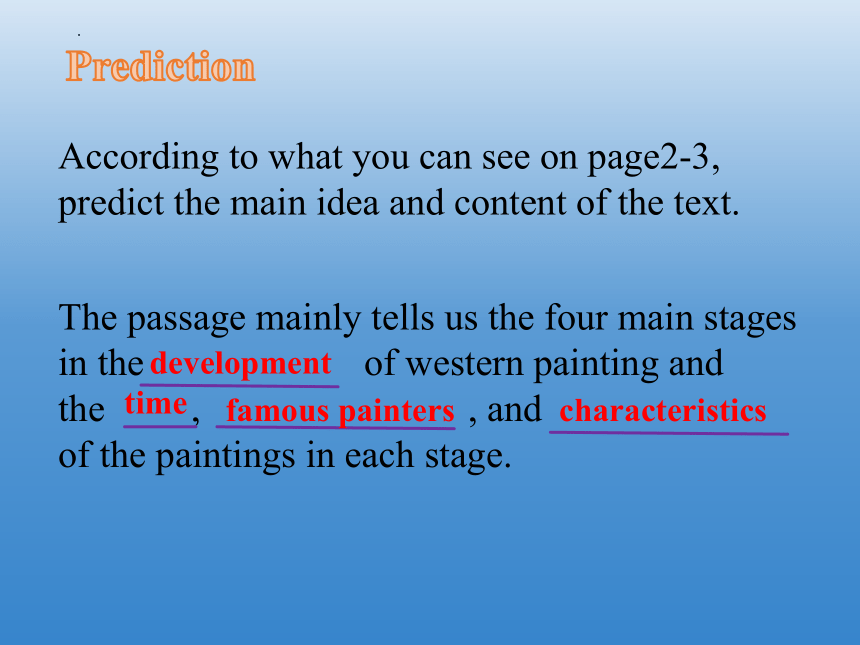
文档简介
(共16张PPT)
reading and thinking
Unit 1 Art
Learning Objectives
By the end of this period, most students will be able to:
1. learn about the development of the western painting, and the time, artists as well as the charecteristcs of each stage.
2. understand the passage in detail, and talk about “art” freely.
3. talk about the short history of western painting and their preferences.
Love of beauty is taste. The creation of beauty is art.
-Ralph Waldo Emerson
对美的喜爱是品味。对美的创造是艺术。
-拉尔夫 沃尔多 爱默生
What do you know about this painting
The painting is of the fresco (湿壁画) painting School of Athens by Raphael (拉斐尔, 1483-1520). It was painted between 1509 and 1511 on a wall in the Apostolic Palace in Vatican City (梵蒂冈城的使徒宫殿).The fresco shows many famous philosophers such as Plato, Aristotle, Socrates, and Pythagoras, though it is not clear who they all are. Although all shown together, they were not all contemporaries (同时期的;同一时代的).
Why did the painter put all these people living at different times together
Why do you think the painter created this work of art What idea did the painter want to convey
Though these people were from different times, they all symbolised human pursuit of wisdom and truth.
To praise the so-called “Golden Age” in history and convey a yearning for a free and open future.
What can you see from the picture
Title: A short history of western painting
Subtitles:
The Middle Ages
The Renaissance
Impressionism
Modern Art
illustrations
Prediction
According to what you can see on page2-3, predict the main idea and content of the text.
The passage mainly tells us the four main stages in the of western painting and the , , and of the paintings in each stage.
development
time
famous painters
characteristics
Fast reading
1.Who are the target readers of this passage
2.Why does the author use subheadings in the passage
People who are interested in art, especially paintings.
To make the ideas or the main content clearly presented.
Careful reading
read the passage and make a flow chart to show the changes in Western painting styles.
The Middle Ages
The Renaissance
Impressionism
Modern Art
time characteristics famous painters
Period 1 The Middle Ages (Para. 2)
Time From the 5th to the 15th century
Characteristics
Famous painters
●religious themes
●not realistic; primitive and two-dimensional
●13th century; more realistic and showed people in a real environment
Giotto di Bondone
Period 2 The Renaissance (Para. 3-5)
Time From the 14th to the 17th century
Characteristics
Famous painters
●less religious themes
●more humanistic attitude to life
●use of perspective; use of oil paints
●deep colours and realism; look like photographs
●emphasis shifted to people and the world around us
portraits of people of high rank
●themes of historical events and mythology
Leonardo da Vinci; Michelangelo;
Raphael; Rembrandt
Period 3 Impression (Para. 6-7)
Time From the 19th to early 20th century
Characteristics
Famous painters
●followed invention of photography
●Paintings were not needed to preserve what things looked like.
●aimed to convey light and movement rather than recording realistic detail
●focused on people, nature, and daily life
●full of light, shadow, colour, and life
●showed inner life of the subject too
Claude Monet; Renoir
Renoir
雷诺阿
Period 4 Modern Art (Para. 8)
Time From the 20th century to today
Characteristics
Famous painters
●analysed shapes of the natural world in a new way
●realistic but dream-like qualities
●abstract
● no longer showed reality, but asked the question “what is art ” in different ways
Picasso
Post reading
Match the paintings below with the correct period of art. Use the information in the reading passage to help you.
___________________
_________________
________________
The Renaissance
Impressionism
Modern Art
Modern Art
__________________
Discuss the following questions with your group members and give a presentation.
1.Which period of Western art do you like most Why are you fond of it
2.How would you answer the questio ‘What’s art’
Thinking
Thanks for your listening!
reading and thinking
Unit 1 Art
Learning Objectives
By the end of this period, most students will be able to:
1. learn about the development of the western painting, and the time, artists as well as the charecteristcs of each stage.
2. understand the passage in detail, and talk about “art” freely.
3. talk about the short history of western painting and their preferences.
Love of beauty is taste. The creation of beauty is art.
-Ralph Waldo Emerson
对美的喜爱是品味。对美的创造是艺术。
-拉尔夫 沃尔多 爱默生
What do you know about this painting
The painting is of the fresco (湿壁画) painting School of Athens by Raphael (拉斐尔, 1483-1520). It was painted between 1509 and 1511 on a wall in the Apostolic Palace in Vatican City (梵蒂冈城的使徒宫殿).The fresco shows many famous philosophers such as Plato, Aristotle, Socrates, and Pythagoras, though it is not clear who they all are. Although all shown together, they were not all contemporaries (同时期的;同一时代的).
Why did the painter put all these people living at different times together
Why do you think the painter created this work of art What idea did the painter want to convey
Though these people were from different times, they all symbolised human pursuit of wisdom and truth.
To praise the so-called “Golden Age” in history and convey a yearning for a free and open future.
What can you see from the picture
Title: A short history of western painting
Subtitles:
The Middle Ages
The Renaissance
Impressionism
Modern Art
illustrations
Prediction
According to what you can see on page2-3, predict the main idea and content of the text.
The passage mainly tells us the four main stages in the of western painting and the , , and of the paintings in each stage.
development
time
famous painters
characteristics
Fast reading
1.Who are the target readers of this passage
2.Why does the author use subheadings in the passage
People who are interested in art, especially paintings.
To make the ideas or the main content clearly presented.
Careful reading
read the passage and make a flow chart to show the changes in Western painting styles.
The Middle Ages
The Renaissance
Impressionism
Modern Art
time characteristics famous painters
Period 1 The Middle Ages (Para. 2)
Time From the 5th to the 15th century
Characteristics
Famous painters
●religious themes
●not realistic; primitive and two-dimensional
●13th century; more realistic and showed people in a real environment
Giotto di Bondone
Period 2 The Renaissance (Para. 3-5)
Time From the 14th to the 17th century
Characteristics
Famous painters
●less religious themes
●more humanistic attitude to life
●use of perspective; use of oil paints
●deep colours and realism; look like photographs
●emphasis shifted to people and the world around us
portraits of people of high rank
●themes of historical events and mythology
Leonardo da Vinci; Michelangelo;
Raphael; Rembrandt
Period 3 Impression (Para. 6-7)
Time From the 19th to early 20th century
Characteristics
Famous painters
●followed invention of photography
●Paintings were not needed to preserve what things looked like.
●aimed to convey light and movement rather than recording realistic detail
●focused on people, nature, and daily life
●full of light, shadow, colour, and life
●showed inner life of the subject too
Claude Monet; Renoir
Renoir
雷诺阿
Period 4 Modern Art (Para. 8)
Time From the 20th century to today
Characteristics
Famous painters
●analysed shapes of the natural world in a new way
●realistic but dream-like qualities
●abstract
● no longer showed reality, but asked the question “what is art ” in different ways
Picasso
Post reading
Match the paintings below with the correct period of art. Use the information in the reading passage to help you.
___________________
_________________
________________
The Renaissance
Impressionism
Modern Art
Modern Art
__________________
Discuss the following questions with your group members and give a presentation.
1.Which period of Western art do you like most Why are you fond of it
2.How would you answer the questio ‘What’s art’
Thinking
Thanks for your listening!
